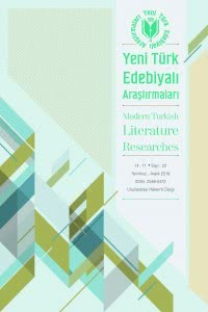TONI MORRISON’IN BELOVED VE CHRISTA WOLF’UN MEDEA. STIMMEN ADLI ESERLERİNDE ANNE ARKETİPİ
Medea, çağlar boyunca edebiyatta ve sanatta konu edilmiş, her dönemde çekiciliğini yitirmemiş bir arketip olarak yer almaktadır. Toni Morrison’ın Beloved (Sevilen) ve Christa Wolf’un Medea. Stimmen (Medea. Sesler) adlı eserleri Yunan mitolojisinde yer alan Medea mitini yeniden üretmekte ve dönüştürmektedir. Beloved ve Medea. Stimmen’in, anaerkil ve Dionizyak birer roman olarak başkahramanları Sethe ve Medea ile ataerkil, sömürgeci Batılı topluma karşı çıkan, değerleriyle mücadele eden Ana Tanrıçalar yarattıkları görülmektedir.
Çalışmada, Beloved ve Medea. Stimmen adlı romanlarda Medea arketipi ile ilişkili olarak yer alan anne arketipi, Apollon-Dionysos dikotomisi bağlamında arketipsel eleştiri yöntemi kullanılarak karşılaştırmalı olarak incelenmeye çalışılacaktır. Eserlerin başkahramanları olan Sethe ve Medea, Carl Gustav Jung’un seven anne ve korkunç anne kavramları açısından değerlendirilecektir. Medea’nın Amerikan ve Alman edebiyatındaki görünümlerinin karşılaştırmalı olarak ele alındığı bu çalışmanın, karşılaştırmalı edebiyat alanına farklı bir bakış açısı ile katkı sağlaması hedeflenmektedir.
Anahtar Kelimeler:
Toni Morrison, Beloved, Christa Wolf, Medea. Stimmen, Medea, Anne arketipi
THE MOTHER ARCHETYPE IN TONI MORRISON’S BELOVED AND CHRISTA WOLF’S MEDEA. STIMMEN
Medea, as a literary archetype has always been the subject of literature and art throughout the ages and has not lost its charm in any period. Toni Morrison’s Beloved and Christa Wolf’s Medea. Stimmen reproduce and transform the myth of Medea in Greek mythology. As matriarchal and Dionysian novels, Beloved and Medea. Stimmen, create goddesses through their protagonists Sethe and Medea who are opposed to the patriarchal, colonial Western society and struggle with its values.
In this study, the mother archetype associated with the Medea archetype in the novels Beloved and Medea. Stimmen will be studied comparatively in the context of Apollo-Dionysus dichotomy using the archetypal criticism method. The protagonists of the works, Sethe and Medea, will be analyzed in terms of Jung’s loving mother and terrible mother archetypes. The aim of this study, in which Medea’s reflections in American and German literature are dealt with comparatively, is to contribute to the field of comparative literature with a different perspective.
Keywords:
Toni Morrison, Beloved, Christa Wolf, Medea. Stimmen, Medea, mother archetype,
___
- Atwood, Margaret (1998). “Introduction”. Medea: A Modern Retelling. Christa Wolf, J. Cullen (Çev.). New York: Doubleday.
- Beaulieu, Elizabeth Ann (Der.) (2003). The Toni Morrison Encyclopedia. USA: Greenwood.
- Biesenbach, Ellen ve Schössler, Franziska (1998). “Zur Rezeption des Medea-Mythos in der zeitgenössischen Literatur: Elfriede Jelinek, Marlene Streeruwitz und Christa Wolf”. Freiburger Frauen Studien: 1: 31-59.
- Campbell, Joseph (1995). İlkel Mitoloji: Tanrının Maskeleri. K. Emiroğlu (Çev.), Ankara: İmge.
- Chandra, Giti (2009). “Remembering and Dismembering: Toni Morrison’s Beloved and Sula”. Narrating Violence, Constructing Collective Identities. USA: Palgrave Macmillan.
- Demetrakopoulos, Stephanie A. (1992). “Maternal Bonds as Devourers of Women’s Individuation in Toni Morrison’s Beloved”. African American Review. Vol. 26, No. 1, Women Writers Issue (Spring, 1992), 51-59, URL: https://www.jstor.org/stable/3042076.
- Dobson, Darrell (2005). “Archetypal Literary Theory in the Postmodern Era”. Journal of Jungian Scholarly Studies. Vol. 1, No. 1.
- Eliade, Mircae (2003). Dinler Tarihine Giriş. L. Arslan (Çev.). İstanbul: Kabalcı.
- Euripides (2014). Medea. A. Çokona (Çev.). İstanbul: Türkiye İş Bankası Kültür.
- Fordham, Frieda (2015). Jung Psikolojisinin Ana Hatları. A. Yalçıner (Çev.). 9. Basım. İstanbul: Say.
- Furman, Jan (2014). Toni Morrison’s Fiction: Revised and Expanded Edition. USA: University of South Carolina.
- Fuston-White, Jeanna (2002). “‘From the Seen to the Told’: The Construction of Subjectivity in Toni Morrison’s Beloved”, African American Review. Vol. 36, No. 3 (Autumn, 2002). USA: The Johns Hopkins University, 461-473.
- Holloway, Karla F.C. (1990). “Beloved: A Spiritual.” Callaloo. 13.3: 516-525.
- Jung, Carl Gustav (2013). Dört Arketip. Z. Aksu Yılmazer (Çev.). İstanbul: Metis.
- McDonald, Marianne (1997). “Medea as Politician and Diva: Riding the Dragon into the Future”, Derleyen: J. J. Clauss ve S. Iles Johnston, Medea: Essays on Medea Myth, Literature, Philosophy, and Art, Princeton University Press, USA 297-323.
- Morrison, Toni (2000). Sevilen. P. Özgören (Çev.). İstanbul: Can.
- Morrison, Toni (2004). Beloved. New York: Vintage Books.
- Neumann, Erich (1974). The Great Mother. Second Printing. USA: Princeton University.
- Stave, Shirley A. (1993). “Toni Morrison’s “Beloved” and the Vindication of Lilith”. South Atlantic Review. Vol. 58, No. 1 (Jan., 1993), 49-66.
- Temple, Robert (2004). “Giriş”. Altın Dal. Sir James Frazer. M. H. Doğan (Çev.). İstanbul: YKY, 7-10.
- Trace, Jacqualine (1991). “Dark Goddesses: Black Feminist Theology in Morrison’s Beloved”. Obsidian II, Vol. 6, No. 3 (Winter 1991), 14-30. https://www.jstor.org/stable/44485265. (Erişim: 10.06.2020).
- Walters, Tracey L. (2007). African American Literature and the Classicist Tradition: Black Women Writers from Wheatley to Morrison. New York: Palgrave Macmillan.
- Wolf, Christa (2000). Medeia/ Sesler. T. Kurultay (Çev.). İstanbul: Telos.
- Yetim, Arzu (2019). Modern Dünya Edebiyatında Medea Mitinin Görünümlerine Arketipsel Bir Yaklaşım. Doktora Tezi. Eskişehir: Eskişehir Osmangazi Üniversitesi.
- ISSN: 1308-8203
- Yayın Aralığı: Yılda 2 Sayı
- Başlangıç: 2009
- Yayıncı: Türk Edebiyatı Vakfı
Sayıdaki Diğer Makaleler
TONI MORRISON’IN BELOVED VE CHRISTA WOLF’UN MEDEA. STIMMEN ADLI ESERLERİNDE ANNE ARKETİPİ
İSMET ÖZEL’İN AMENTÜ ŞİİRİ ÜZERİNE SEMBOLİK BİR OKUMA
TÜRK ŞİİRİNİN İMGEYLE İMTİHANI
BİLİNMEYEN SULAR’DA KAÇINILMAZ İKİLEM
GÜVEN TURAN’IN DALYAN ROMANINDA BENLİK ARAYIŞI
VARLIK TABAKALARI ARASINDAKİ ÇATIŞMA BAĞLAMINDA ABBAS SAYAR’IN YILKI ATI ROMANI
QUEER ESTETİK BAĞLAMINDA ARKADAŞ Z. ÖZGER ŞİİRİNİN İNCELENMESİ
TANPINAR’IN “GEÇMİŞ ZAMAN ELBİSELERİ” HİKÂYESİNİ FENOMENOLOJİK VE ONTOLOJİK YORUMLAMA DENEMESİ
